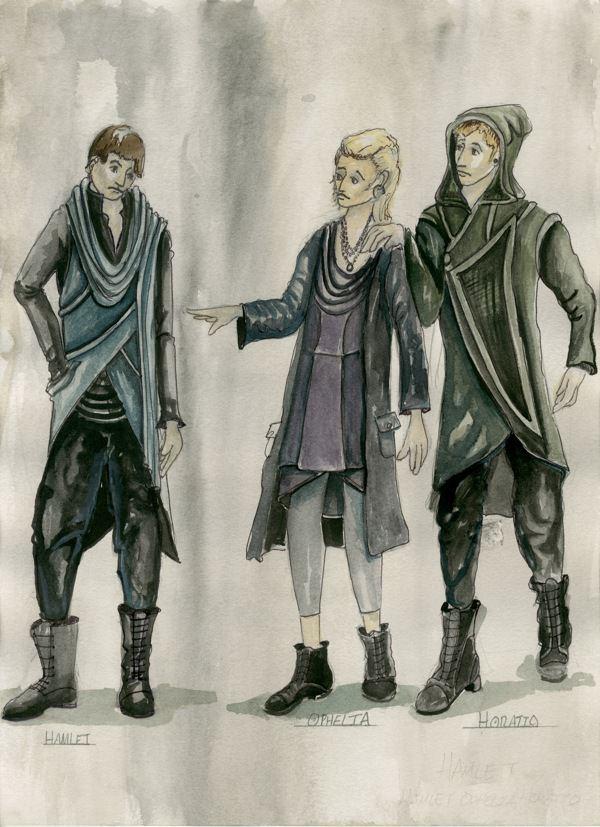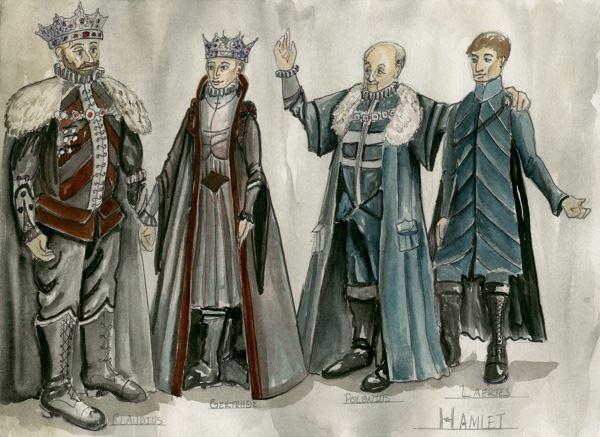Scenic design is a vital element in every play. The design portrays the style and the mood of the production used in the play. It also enables the audience to draw a clear distinction between a nonrealistic and a realistic theater. One important element of scene design is design of the costumes. A costume design contributes to communication of the tone and mood in the play.
The features of the costumes such as color, texture, size, and shape play an important role in communicating the tone of the play and also influence the feelings of the audience (Cole & Burke 230). This study looks at the costume design in Hamlet with reference to the characters in act 3 scenes 3.
Setting
Based on the setting In Hamlet, It is widely evident that Hamlet is one of the Shakespeare’s plays, which has a sense of modernity. The effect is communicated through the scene setting. The play is introduced in the modern Denmark. To elucidate the aspect of modernity in act one scene one of the play, Shakespeare uses the two watchmen Bernado and Francisco to portray issue of work shifts (Lionel 120).
The aspect of modernity is also exhibited in the play by the characters themselves. Another aspect that communicates the element of modernity in the play is behavior of the characters. For example, Hamlet is portrayed as a university student who has rebelled against the will of the parents. Hamlet conveys the behavior of the modern youth who has a tendency of rebellion from the parent’s decisions (Lukas 180)
Costume Design
Scene 3 of the play is marked by a feeling of mistrust that is exhibited by the key characters of the play such as Claudius and Hamlet. The two characters do not trust each other due to the circumstances in the play. Claudius has killed his own brother who was Hamlet’s father. Claudius has also gone to the extent of marrying his brother’s wife.
These events are the major causes of mistrust and rivalry between the King and Hamlet. The two have made secrete plans to assassinate each other. The King plans to take Hamlet to England, from where he will be killed by his servants. On other hand, Hamlet plans to kill the King through the assistance of his friends such as Horatio and Ophelia (La Motte 156).
Tension is another key aspect that determines the mood in Denmark kingdom. The king has declared that Hamlet is a threat to his family and to the whole kingdom and should therefore be taken away to ensure safety of the kingdom. In spite of the tension in the kingdom, there is a sudden change in mood in the evening. This occurs when the king goes to the altar to pray (Lukas 222). The King initiates a prayer where he confesses his sins and asks for forgiveness. At the every instance, Hamlet gets the opportunity to interact with the king (Cole & Burke 230).
Hamlet had the main intention of revenging the death of his father. However, during the interaction at the altar he was not able to execute his intentions due to his Christian moralities. These instances portray the Kingdom of Denmark as place characterized by instability, mistrust, and sadness (La Motte 156). The scene portrays the political condition of the kingdom and also reveals the roles of Hamlet in the play.
Based on the above information, the costumes designs for the characters in act 3 scene three of the play will be as shown in the pictures (La Motte 168)

The picture reveals the youthful characters in the scene. As shown in the play the youthful characters will put on clothes that will reflect their youthful nature. Hamlet is dressed in a tight jeans, a T-shirt top, a heavy jacket, boots, and a scarf. The texture of the clothes portrays the mood of the scene. The costume design is the most appropriate for Hamlet to reflect him as a rebel in the kingdom. His attire portrays him as a rebellious youth who is ready to revenge the death of his father. Ophelia is dressed like a cute girl since she is believed to have attracted Hamlets attention. She is dressed in a tight skinny trouser, a heavy jacket, and boots. The costume design for Ophelia in the scene three is very appropriate (Lionel 126). Ophelia conveys the picture of a modern young girl in her early twenties. Her dressing style is also consistent with the setting of the scene where elements of trust, tension, and instability take the day. An audience watching the play would expect a young girl in the modern Denmark kingdom to dress like Ophelia (La Motte 159).
Horratio is another youthful character in the play that portrays the rebellious nature of the modern youth. The character is dressed in a tight a trouser, fitting gumboots, and heavy jacket. He is a great friend to Hamlet. Both characters are university students and therefore their costume design is very appropriate for the scene. The costume design not only communicates the mood, but also conveys the climatic condition in Denmark. The three are dressed in jackets to reveal that the play was produced during the cold season (Lionel 120).
Colors of their costume also communicate the element of tension that is eminent in the kingdom. None of the characters is dressed in bright or warm colors that can be used to portray happiness (Lukas 198). The youthful characters have also been dressed in non bright colors to portray the issue of tension that is common in the Kingdom. The non bright colors also portray lack of trust, which is a major problem in the Kingdom. For instance, Hamlet does not trust anybody especially after the death of his father. The character has lost the trust that he had in friends and relatives.
Claudius, Gertrude, Polonius, and Laertes are some of the key characters in the scene. The design for their costume can be depicted as shown in the picture below (Lionel 128).

From the picture the color of the costumes conveys their status. Claudius is dressed like the king of the kingdom. The King was dressed in grey color to exhibit the mood of tension that is eminent in the kingdom. His costume has been designed to express his social and political status as the king of Denmark. Next to the king is Gertrude, the Queen of Denmark. Her costume reveals her status and the mood in the kingdom. Unlike the king and Queen, Polonius and Laertas are dressed in bright blue colors. The two are close friends to the King. However, their costume indicates they are not ready to help the King solve his problems. Polonius and Laertas have a higher social class in the Kingdom. Unlike, Hamlet and Horratio, Polonius and Laertas are non rebels of the kingdom; they are mature adults who are ready to cooperate with the king (Lionel 127).
King Claudius is another character in the play who exhibits the negative characters of greed, betrayal and mistrust. The King is believed to have killed his own brother in order to succeed him. Moreover, the king has decided to marry his brother’s wife barely two months after the death of the brother. These issues portray the moral evils in the modern society. Therefore, the costume design for the king must embrace the element of modernity. The Queen on the other hand also exhibits the moral evils of the modern day. The Queen betrays his husband by marrying the King immediately after the death of the husband. Her main intention of marrying the king was to ascend to power and enjoy the privileges that come with the post (La Motte 156).
Grey colors as seen in the scene are important in communicating the issue of political instability in the Kingdom. The King and the Queen are dressed in costumes that are mainly grey in color due to restlessness in the Kingdom. The two are already aware of Hamlet’s intention to revenge the death of his father (Lukas 198). The King has tried all means possible to kill Hamlet in order to ensure sustainability of his political career. Hamlet on the other hand plans to kill the King and recover his father’s political seat. The act of rivalry between Hamlet and the King has caused political tension in Denmark Kingdom. This aspect can be communicated effectively through the grey color of the costumes. The mixture of the colors as indicated in the pictures highlight the element of mood swings that is eminent in the scene. For example, after the King had made a plan to deport Hamlet to England, the mood of the play changes from tension to a bearable tranquility when the King went to the altar to confess his sins (Lukas 198).
The grey colors also portray lack of trust that is eminent between the King and Hamlet. There is lack of transparency in the play. The grey colors also highlight the activities of the king that are done in secret to sustain power. For example, the king murdered his brother and secretly married his wife. These characters of the king can be portrayed clearly by dressing him in grey costumes. The Queen is also dressed in grey color to highlight of lack of trust between her and Hamlet. Despite the fact the Queen is Hamlet’s mother; she is not willing to share any information with Hamlet regarding her marriage with the King. The Queen does not disclose any information to Hamlet concerning the death of her husband (La Motte 156).
Design of the costumes has also embraced the element of weather. For example, all the characters in the scene are dressed in costumes that portray the weather condition of the Kingdom. The costumes reveal that scene was produced during the cold season since most of the characters are dressed in warm attires (Cole & Burke 234).
Works Cited
Cole, Holly, & Burke, Kristin. Costuming for Film: The Art and the Craft, New York: Silman-James Press, 2005. Print.
La Motte, Richard. Costume Design 101: The Art and Business of Costume Design for Film and Television, New York: Michael Wiese Productions, 2010. Print.
Lionel, Abel. Tragedy and Metatheatre: Essays on Dramatic Form, New York: Holmes Meier Publishers, 2003. Print.
Lukas, Erne. Shakespeare as Literary Dramatist, Cambridge: Cambridge University Press, 2008. Print.